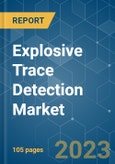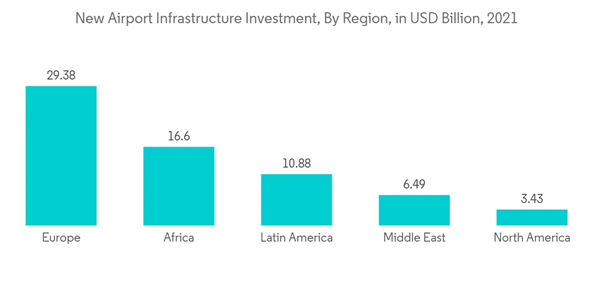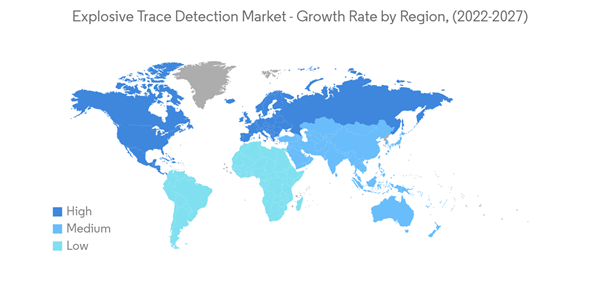The explosive trace detection market is expected to grow at a CAGR of more than 8% during the forecast period.
Explosives trace detectors (ETDs) are used by public safety organizations to vehicles, screen packages, luggage, and other items for tiny residues of explosives. The ETDs are used in various end-user industries. The explosive trace detection market witnessed the significant impact of the COVID-19 pandemic. Production halts from OEMs, supply chain disruptions due to lockdowns, and reduced demand from end users hinder the market growth during the pandemic period. The market showcased recovery after the pandemic in 2021 due to relaxations in lockdown restrictions and increasing airline operations.
An explosive trace detection system that samples an explosive trace from the surface of an object. The system is used to check the presence and type of explosive. Increasing security screening rules and regulations from the various security agencies drive the growth of the market. The Transportation Security Administration (TSA) is responsible for the security of travelers across the United States. TSA uses various technologies to conduct passenger screening at the security checkpoint. It uses millimeter wave advanced imaging technology to screen passengers for metallic as well as non-metallic threats such as weapons and explosives.
Furthermore, increasing terrorist activities and illegal weapon transfer lead to rising security concerns which drive the growth of the market.
Increasing air traffic, growing investments in airport security, and stringent government rules for enhanced security at airports drive the growth of the market. ETD technology is used at checkpoints and boarding areas, where the airport authority conducts screenings. The increasing incidents of terrorist activities require airports to use explosive trace detectors.
For instance, in August 2022, Smiths Detection started the installation of 30 HI-SCAN 6040 CTiX carry-on baggage screening systems at Leonardo di Vinci International Airport in Rome. The company’s HI-SCAN 6040 CTiX is a computed tomography (CT) X-ray scanner that produces high-resolution volumetric 3D images for quick baggage assessment and low false-alarm rates. There are more than 950 security system units deployed at about 340 airports in the United States. The agency also uses explosive trace detection technology to screen passengers for trace amounts of explosive residue. Thus, the growing use of ETDs at airports for enhanced security boosts the market growth during the forecast period.
Furthermore, the growing focus of ETD OEMs on business expansion through contracts, mergers and acquisitions, and agreements drive market growth. For instance, in April 2021, the Indian Institute of Technology (IIT)- in Bombay incubated NanoSniff Technologies developed the world's first micro-sensor-based explosive trace detector (ETD). It can detect explosives in less than 10 seconds and also identifies and categorizes explosives into different classes. It can detect all classes of conventional, military, and homemade explosives.
This product will be delivered within 2 business days.
Explosives trace detectors (ETDs) are used by public safety organizations to vehicles, screen packages, luggage, and other items for tiny residues of explosives. The ETDs are used in various end-user industries. The explosive trace detection market witnessed the significant impact of the COVID-19 pandemic. Production halts from OEMs, supply chain disruptions due to lockdowns, and reduced demand from end users hinder the market growth during the pandemic period. The market showcased recovery after the pandemic in 2021 due to relaxations in lockdown restrictions and increasing airline operations.
An explosive trace detection system that samples an explosive trace from the surface of an object. The system is used to check the presence and type of explosive. Increasing security screening rules and regulations from the various security agencies drive the growth of the market. The Transportation Security Administration (TSA) is responsible for the security of travelers across the United States. TSA uses various technologies to conduct passenger screening at the security checkpoint. It uses millimeter wave advanced imaging technology to screen passengers for metallic as well as non-metallic threats such as weapons and explosives.
Furthermore, increasing terrorist activities and illegal weapon transfer lead to rising security concerns which drive the growth of the market.
Explosive Trace Detection Market Trends
Commercial Segment is Projected to Show Significant Growth During the Forecast Period
The commercial segment of the market is expected to show significant growth during the forecast period. The growth is attributed to the increasing security concerns and stringent government rules for the aviation sector. Rising terrorism and illegal arms transfer lead to rising demand for advanced security systems which drive market growth. The ETDs can detect drugs, narcotic substances, and deadly explosive chemicals such as Ammonium Nitrate, Nitro-glycerine, and RDX in less time.Increasing air traffic, growing investments in airport security, and stringent government rules for enhanced security at airports drive the growth of the market. ETD technology is used at checkpoints and boarding areas, where the airport authority conducts screenings. The increasing incidents of terrorist activities require airports to use explosive trace detectors.
For instance, in August 2022, Smiths Detection started the installation of 30 HI-SCAN 6040 CTiX carry-on baggage screening systems at Leonardo di Vinci International Airport in Rome. The company’s HI-SCAN 6040 CTiX is a computed tomography (CT) X-ray scanner that produces high-resolution volumetric 3D images for quick baggage assessment and low false-alarm rates. There are more than 950 security system units deployed at about 340 airports in the United States. The agency also uses explosive trace detection technology to screen passengers for trace amounts of explosive residue. Thus, the growing use of ETDs at airports for enhanced security boosts the market growth during the forecast period.
Asia Pacific Will Showcase Remarkable Growth During the Forecast Period
Asia Pacific is projected to show significant growth in the explosive trace detection market during the forecast period. The growth is due to the increasing defense expenditure from China and India and rising terrorism across the region. Increasing security concerns at airports and stringent regulations from law enforcement agencies for enhanced security boost market growth. For instance, in July 2022, the Kolkata Police Special Branch in India is spending Rs 2 crore for the procurement of nine handheld explosive detection devices to improve security for VVIPs. The devices are also capable to detect narcotics. Furthermore, in September 2021, Incheon International Airport Corporation (IIAC), a South Korea-based airport signed a contract with Smiths Detection to install its explosives detection system (EDS) HI-SCAN 10080 XCT for hold baggage screening at Incheon International Airport (ICN) Terminal 2. The deployment aims to complete by 2024. Thus, the growing focus on improving security and rising procurement of advanced explosive trace detectors from security agencies propel the growth of the market across the Asia Pacific.Explosive Trace Detection Market Competitor Analysis
The explosive trace detection market is fragmented in nature with the presence of several global and local players holding significant shares in the explosive trace detection market. Some prominent market players are Teledyne FLIR LLC, OSI Systems Inc., Leidos, Smiths Detection Group Ltd., and Analogic Corporation. Several players are involved in the design and development of advanced explosive trace detectors that are capable of detecting minute explosive particles.Furthermore, the growing focus of ETD OEMs on business expansion through contracts, mergers and acquisitions, and agreements drive market growth. For instance, in April 2021, the Indian Institute of Technology (IIT)- in Bombay incubated NanoSniff Technologies developed the world's first micro-sensor-based explosive trace detector (ETD). It can detect explosives in less than 10 seconds and also identifies and categorizes explosives into different classes. It can detect all classes of conventional, military, and homemade explosives.
Additional benefits of purchasing the report:
- The market estimate (ME) sheet in Excel format
- 3 months of analyst support
This product will be delivered within 2 business days.
Table of Contents
1 INTRODUCTION
4 MARKET DYNAMICS
5 MARKET SEGMENTATION
6 COMPETITIVE LANDSCAPE
Companies Mentioned (Partial List)
A selection of companies mentioned in this report includes, but is not limited to:
- Analogic Corporation
- Autoclear, LLC.
- Bruker
- Leidos
- OSI Systems, Inc.
- Smiths Detection Group Ltd.
- Teledyne FLIR LLC
- DetectaChem
- RS Dynamics
- Morphix Technologies
Methodology

LOADING...










